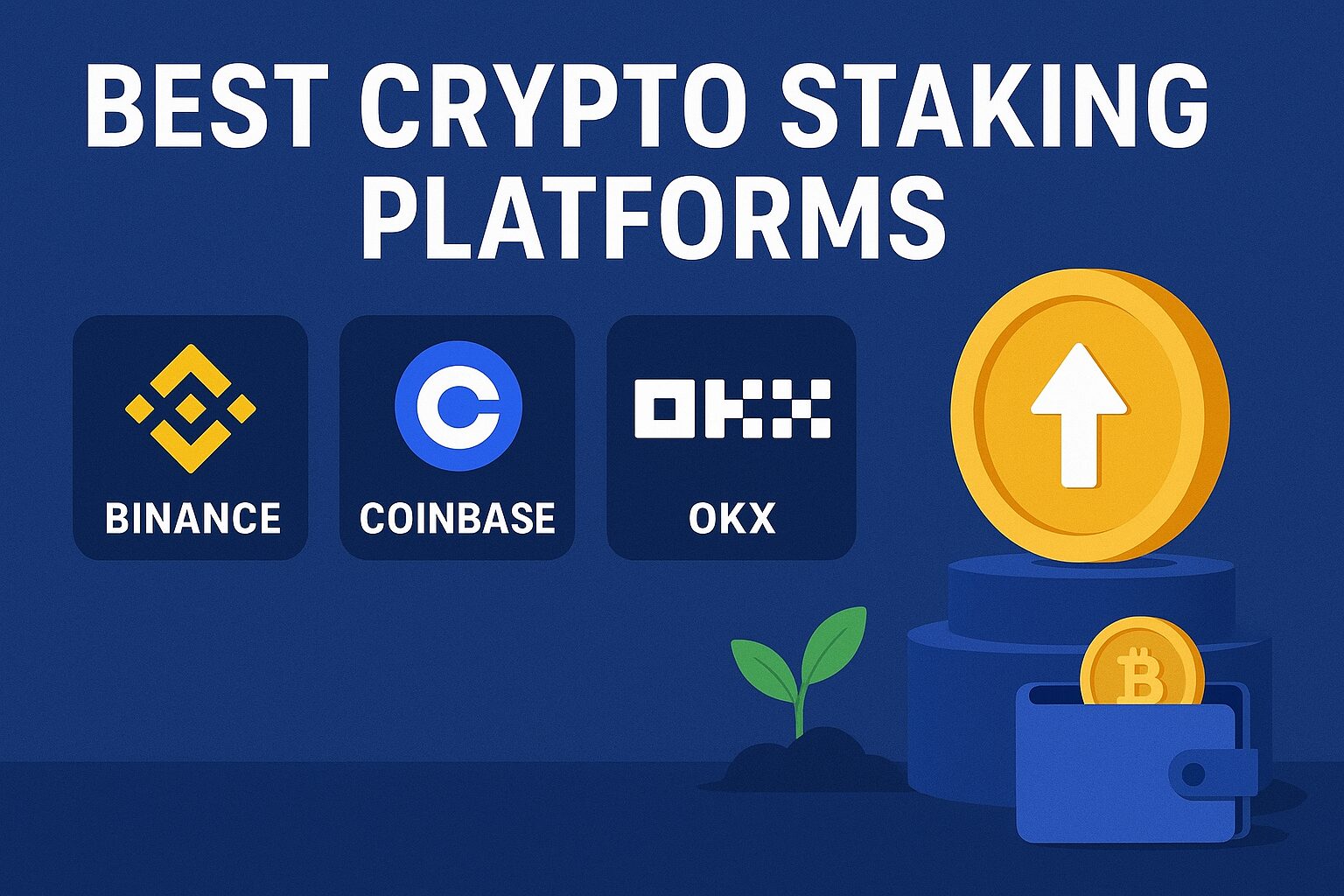Cryptocurrency staking has become one of the favorite ways for crypto owners to earn passive income. By using the best crypto staking platforms, people can stake their coins, help secure blockchain networks, and earn rewards in return.
In this article, we’ll cover:
- What crypto staking really means
- Its benefits and risks
- What to look for when choosing a staking platform
- A detailed review of the best crypto staking platforms in 2025
- Tips to maximize your staking rewards
Let’s dive into what staking is, why it matters, and which platforms are trustworthy so you can earn without too much worry.
What is Crypto Staking?
Definition and How Staking Works
Staking is the act of locking up a certain amount of cryptocurrency (coins or tokens) to support the operations of a blockchain network. In return, you get rewards usually more crypto.
Think of staking like putting money in a savings account: you deposit, you get interest. But here, depositing means locking your crypto, and interest means earning more crypto.
Proof‑of‑Stake (PoS) vs. Proof‑of‑Work (PoW)
Here are simple differences:
| Feature | Proof‑of‑Work (PoW) | Proof‑of‑Stake (PoS) |
|---|---|---|
| How blocks are validated | Miners use computing power to solve puzzles | Validators stake coins and are chosen to validate based on stake and other rules |
| Energy use | Very high (lots of electricity) | Much lower, more energy efficient |
| Barrier to entry | Need mining hardware, high cost | Need to own coins, sometimes minimal amount, less hardware cost |
| Risk of centralization | Big operations with expensive hardware dominate | Big stakeholders may have more influence, risk of centralization if many coins are controlled by few entities |
Ethereum’s shift from PoW to PoS is a good example: big drop in energy, more accessible staking.
Types of Staking: Centralized, Decentralized, and DeFi
- Centralized staking: Using exchanges or platforms like Binance, Coinbase, Crypto.com. You trust them to keep your coins safe and give rewards.
- Decentralized staking: Directly staking by running your own node or using protocols that let you participate without giving up control of your coins.
- Liquid staking / DeFi staking: You stake but still get a token representing your stake so you can use it elsewhere (in DeFi), trade, or keep liquidity.
Risks and Rewards of Staking
Rewards:
- Regular staking rewards / APYs
- Compound growth (earning on rewards)
- Supporting blockchain security
- Passive income (you don’t have to actively trade)
Risks:
- Locked period: you may not be able to withdraw immediately
- Slashing: if validator misbehaves, you could lose part of your stake
- Platform risk: hacks, insolvency, or mismanagement
- Regulatory risk: laws around staking differ by country
Key Factors to Consider When Choosing a Staking Platform
Before you stake your crypto, here are things you must check. These will help you choose the best crypto staking platforms for your needs.
- Security and Platform Reputation
- Has the platform been audited?
- Does it have a history of hacks or major issues?
- How long it has been operating?
- Supported Cryptocurrencies
- Which coins/tokens can you stake? (ETH, ADA, SOL, DOT, etc.)
- Does it support smaller / newer PoS coins?
- Staking Rewards / APY
- How much reward (percentage) you get yearly
- Is the APY fixed or variable?
- How often is reward paid out (daily, weekly, monthly)?
- Lock‑up Periods and Liquidity
- For how long you must lock your funds
- Whether you can unstake anytime
- Whether there are penalties for early unstaking
- Fees and Commissions
- Does the platform take a cut of rewards?
- Are there deposit/withdrawal fees?
- Hidden costs (gas fees, withdrawal delays)?
- User Interface and Experience
- Is it easy to stake?
- Is dashboard clear?
- Mobile app / web usability
- Regulatory Compliance
- Does the platform follow local laws?
- Is it regulated / licensed?
- What happens if laws change?
Best Crypto Staking Platforms in 2025
Here are some of the best staking platforms, with their pros, cons, coins supported, estimated APY, and what makes them unique.
Note: APYs change often. The numbers below are approximate at time of writing.
| Platform | Overview | Pros | Cons | Supported Coins / Tokens | Estimated APY* | Unique Features |
|---|---|---|---|---|---|---|
| A. Binance | Major exchange, large user base, wide staking options | Very many assets to stake; competitive APY; good UI; strong liquidity | Sometimes long lock‑up; fees / commission can eat into rewards; regulatory concerns in some jurisdictions | ETH, ADA, SOL, BNB, and many others (130+ staking assets) | ~ 5‑8% for many PoS coins, higher in special offers | “Binance Earn” programs, flexible and locked staking, dual investment features |
| B. Coinbase | US‑based, very large, known for ease of use | Very trustworthy for many beginners; simple UI; strong security | Smaller number of assets; lower APY in many cases; sometimes slower rewards or longer lock periods | ETH, ADA, SOL, DOT, etc., but fewer than Binance | ~ 4‑6% typical; depends on coin | Strong reputation; auto‑staking options; integration with many US‑friendly services |
| C. Kraken | Long‑standing, known for security and compliance | Good APY; many staking and node operation options; transparent fees | Might require higher minimums; interface less beginner‑friendly for some | ETH, DOT, ADA, SOL, etc. | Similar to Coinbase / Binance depending on coin (≈ 5‑7%) | “Own Node” options, flexible staking; good for more advanced users |
| D. Lido | Liquid staking protocol, especially for ETH | High liquidity, no lock (or low lock), you get liquid token you can use elsewhere | Risks of smart contract; centralization concerns; fees on staking rewards | Mainly ETH; also supports other PoS tokens in some chains | ~ 4‑5% for ETH staking but can vary; liquid staking premium | Liquid staking, tokenized stake (e.g. stETH), wide DeFi integration |
| E. eToro | Social trading + staking features | Good UI; combines investing and staking; easy for beginners | Less control; fewer assets; sometimes higher fees | Selected PoS coins | ~ 4‑6% depending on coin | Social features; everything in one app for investing & staking |
| F. Crypto.com | Well known with many crypto services | Frequently promotions with high APY; mobile‑friendly; large coin selection | Some lock‑ups; fees; app promotions may change; customer support concerns in some regions | Many PoS and semi‑PoS coins | Can go up to 8‑10%+ in special promotions; normal rates lower | Offers “Supercharger”, “Earn” programs; bonus rewards; Visa card integration |
| G. Rocket Pool | Decentralized ETH staking pool | Minimal minimums; more decentralized; safety with redundancy | Punishment risk; smart contract risk; some complexity | ETH | ~ 4‑5% (ETH) depending on conditions | You can run your own small node or pool; widely trusted in DeFi community |
| H. Ledger Live | Hardware wallet + staking UI | You keep full control of private keys; hardware wallet security; decent APY | Might have fewer assets; small fees; less liquid; may need hardware investment | ETH, ADA, some other major PoS tokens | ~ 4‑6% depending on coin, after fees | Combine self‑custody + staking; ideal for security‑minded users |
| I. Bybit | Exchange with staking + other yield features | Good rewards; promotions; flexible staking options | Possibly regulatory risk depending on location; higher complexity; sometimes lock‑ups | Many PoS tokens | Promotions can yield 7‑12%+ for some coins; base rates lower | Liquid staking / structured staking; diverse offers; frequent APY boosts |
| J. Ankr | DeFi + Web3 staking infrastructure | Very flexible; supports many blockchains; liquid staking options; lower entry barriers | Smart contract risks; sometimes less UI polish; lower brand recognition | ETH, BNB Smart Chain, others; many smaller chains | Can vary widely; in many cases 5‑10% depending on chain and liquidity | Integration with many chains; focus on Web3; good for diversifying smaller tokens |
*Estimates based on data in mid‑2025. Always check current rates before staking.
Visual / Stats Example
Here’s a snapshot of the staking market in 2025 so far, to give you context:
- Global staking market cap reached US$95 billion by end‑2024, up about 58% year over year.
- Liquid staking is now the largest category of ETH staking (~31.1% of all staked ETH). Centralized exchanges hold ~24%.
- Average crypto staking rewards are ~6.08%, which is many times higher than average dividends from S&P 500 (~1‑2%).
Here’s a simple bar chart idea (you can imagine or draw):
Bar Chart: Staked ETH by Type (2025)
| Staking Type | % of Total Staked ETH |
|---|---|
| Liquid staking | ~ 31% |
| Centralized exchanges | ~ 24% |
| Staking pools | ~ 18% |
| Others / unidentified / solo | ~ 27% |
Centralized vs. Decentralized Staking Platforms
Here we compare centralized vs decentralized, show pros & cons, and which might suit beginners vs advanced users.
Comparison Table
| Feature | Centralized Platforms (Exchanges etc.) | Decentralized / Liquid / Self‑Stake Protocols |
|---|---|---|
| Control over keys | No (platform holds them) | Yes (you often hold or control keys) |
| Convenience | Very easy UI; customer service; few technical steps | More technical; may require node setup or interacting with smart contracts |
| Liquidity | Depends; some require lock‑ups, others flexible staking | Liquid staking gives you tokens you can trade; self‑staking may be less liquid |
| Risk | Platform risk (hack, failure) | Smart contract risk; risk from protocol bugs; but often fewer centralized points of failure |
| Fees | Platform takes commission; exchange fees, withdrawal fees | Protocol fees, gas fees, slashing risk; but sometimes lower ongoing fees |
| Transparency | Possibly less; platform may not show every detail | Usually more transparent; open source; community audits |
Pros and Cons of Each
Centralized:
- Very easy for beginners
- Many options, high coin variety
- Good support & sometimes promotions
− You don’t hold private keys (custodial risk)
− Locked periods, possibly high fees
− Less transparency
Decentralized / Liquid / Self‑Stake:
- More control over your crypto
- Greater transparency, more innovative features (liquid staking etc.)
- Usually better for long‑term gains
− More technical complexity
− Smart contract risk
− Liquidity or lock periods vary
Which Type is Best for Beginners vs. Advanced Users
- Beginners will likely prefer centralized platforms because they are simpler, more support, safer from UI mistakes.
- Advanced users or those who want more control, higher flexibility, or to use their stakes in DeFi will do better with decentralized staking or liquid staking protocols.
Tips for Maximizing Staking Rewards
To make the most out of staking, use these tips:
- Diversify Staking Assets
Don’t put all your stake in one coin or platform. If one chain underperforms or has slashing issues, you won’t lose everything. - Understand Compounding
Reinvest your rewards to stake more, which increases the base for future rewards. - Monitor Reward Rates
APYs can change. Sometimes platforms run promotions. Keep an eye on rates and move when a better opportunity arises. - Stay Updated on Protocol Changes
Blockchain networks sometimes change rules (minimum stake, lock‑period, fees). If there is an update (fork, upgrade), your rewards or risk could change. - Check Fees & Hidden Costs
Withdrawal fees, gas fees, or fee cuts by platforms can reduce net rewards a lot. - Think About Liquidity Needs
If you may need the money, choose staking options with no or short lock‑up times or liquid staking.
Risks and Challenges of Crypto Staking
Staking isn’t risk‑free. Understand these common risks before committing your funds.
- Market Volatility: Crypto prices can fall a lot. Even if you earn staking rewards, if price drops, losses may outweigh gains.
- Platform Risk: Exchanges/platforms could suffer hacks, regulatory shutdowns, or insolvency.
- Regulatory Risks: Some countries may restrict staking, tax rewards heavily, or change laws affecting staking legality.
- Validator Slashing & Penalties: If validators (or delegated validators) behave badly or go offline, portion of staked funds may be destroyed.
- Smart Contract Risk: In liquid staking or DeFi protocols, bugs or exploits can result in loss of funds.
- Lock‑up Risk: If your funds are locked and you need cash or want to reallocate, you might not be able to quickly.
Conclusion
Staking is a powerful tool to earn passive income, especially in a growing PoS ecosystem. In 2025, the options are better, more varied, and more liquid than ever.
Here are the key takeaways:
- Examine the security, supported coins, APY, fees, and lock up when choosing a platform.
- Centralized platforms like Binance, Coinbase, Crypto.com are great for ease; decentralized and liquid staking (like Lido, Rocket Pool, Ankr) offer more control.
- Use tips (diversify, compound, monitor) to boost your rewards.
- Always be aware of risks: market, regulatory, contract, and lock‑up risks.
FAQs
What is the safest crypto staking platform?
There’s no one “safest” for everybody. Platforms with long histories, strong security practices, audits, regulated exchanges tend to be safer. For example, established exchanges (Binance, Coinbase, Kraken) or reputed protocols with wide use (Lido, Rocket Pool) are often considered low risk—but still not risk‑free.
Can I lose money staking crypto?
Yes. Because of price drops, slashing, platform failure, or unexpected fees. Even if rewards are attractive, risks make it possible to lose value in fiat terms.
How much can you earn staking?
Earnings vary a lot by coin, platform, lock‑up, and market conditions. Typical APYs are in the range of 4‑10%, sometimes more in promos. But inflation, fees, and price changes matter. Always check current rates.
Is staking better than trading?
They are different. Staking is more passive and less risky (usually) but earnings are smaller and slower. Trading can yield bigger profits or losses, requires more effort, knowledge, and time. For many people, staking + HODLing gives steady income; trading adds risk.
How do crypto staking platforms work?
Staking platforms allow users to deposit their crypto into staking pools or directly delegate it to validators. The platform then distributes staking rewards proportionally to participants.
What are the benefits of staking crypto?
- Earn passive income in the form of staking rewards.
- Contribute to the security and efficiency of the blockchain network.
- Potential long-term gains if the staked asset increases in value.
Are staking rewards guaranteed?
No. Rewards vary depending on the blockchain, network conditions, staking duration, and the platform’s fees.
Is staking crypto safe?
Staking has risks. While it’s safer than trading, risks include price volatility, lock-up periods, slashing penalties (for validator misconduct), and platform hacks. Choosing reputable platforms reduces these risks.
Which cryptocurrencies can I stake?
Popular options include Ethereum (ETH), Cardano (ADA), Solana (SOL), Polkadot (DOT), Avalanche (AVAX), and many more. Availability depends on the platform.
What’s the difference between custodial and non-custodial staking platforms?
- Custodial platforms (like exchanges) hold your crypto and manage staking for you.
- Non-custodial platforms let you keep control of your private keys while delegating your tokens to validators.
How much can I earn from staking?
Earnings vary by crypto and platform. Annual Percentage Yields (APYs) usually range from 3% to 20%, but rates fluctuate with network demand.
Do I need technical knowledge to stake crypto?
Not always. Many platforms make staking beginner-friendly with just a few clicks. However, running your own validator node requires advanced knowledge.
What are the best crypto staking platforms in 2025?
Top platforms often include Binance, Coinbase, Kraken, KuCoin, Lido Finance, and Rocket Pool. The best choice depends on your crypto, risk tolerance, and whether you prefer centralized or decentralized option
Disclaimer
The information in this article is for educational and informational purposes only. It should not be taken as financial or investment advice. Always do your own research (DYOR), check the current terms and conditions of any staking platform, consider your risk tolerance, and consult with a financial advisor if needed. Crypto is volatile, and you could lose all or part of your investment.



